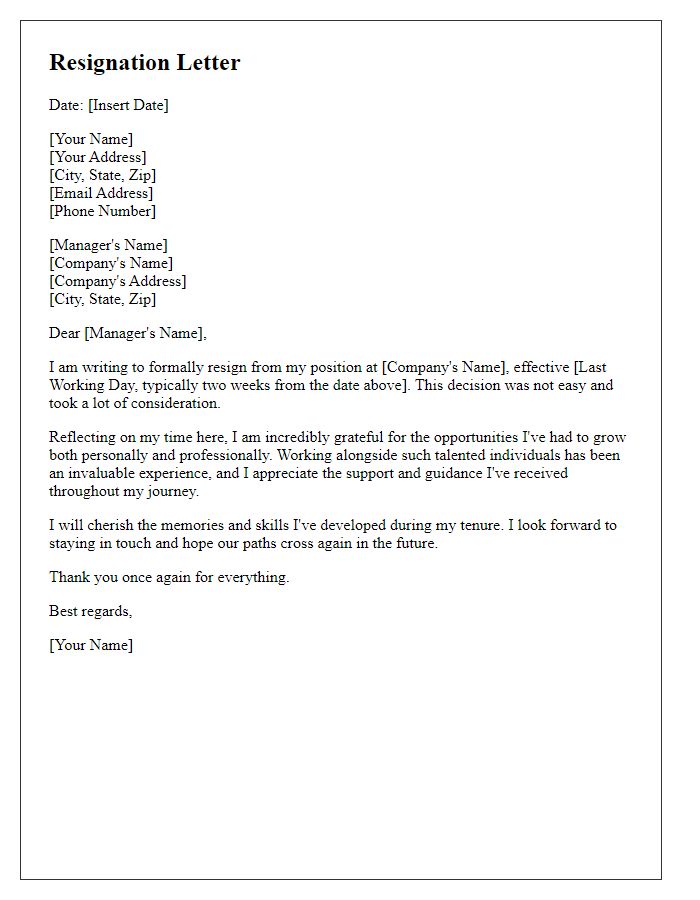Resigning from a job can be a daunting task, but doing it with grace and professionalism is essential for maintaining a positive relationship with your employer. A well-crafted resignation letter not only expresses your intentions clearly but also leaves a lasting impression on your colleagues and management. It's an opportunity to reflect on your experiences and express gratitude for the time spent working together. If you're interested in learning how to write a thoughtful resignation letter, keep reading for expert tips and templates!

Clear and Concise Language
Resigning from a position requires a clear and professional communication style that conveys gratitude and clarity. A letter of resignation typically includes the date of the letter, the recipient's name and position, and a brief statement of intent to resign. Expressing appreciation for the experiences gained during employment is essential. The notice period, usually two weeks, should be clearly stated, along with an offer to assist with the transition. Concluding with well wishes for the company's future endeavors maintains a positive tone. This approach ensures a respectful departure, leaving a lasting professional impression.
Gratitude and Appreciation
Leaving a job gracefully involves expressing gratitude while maintaining professionalism. A resignation letter should highlight appreciation for opportunities and experiences gained. It's important to mention specific contributions or learning moments, fostering a positive tone. For example, acknowledging mentorship from a supervisor, teamwork with colleagues, or valuable skills acquired during tenure can add a personal touch. Providing a clear end date allows for a smooth transition, showing respect for the organization and coworkers. Emphasizing willingness to assist during the handover period further conveys professionalism and dedication to a seamless exit.
Transition Assistance
Transition assistance during a resignation period is crucial for maintaining professionalism and ensuring a smooth handover of responsibilities. Providing documentation such as project files, access credentials, and status updates for ongoing tasks is essential. Communication will involve informing team members and stakeholders about the transition process, clarifying job handover timelines, and offering to train successors on specific duties and systems. Additionally, scheduling an exit interview can provide valuable feedback to the organization and demonstrate a commitment to constructive closure. Overall, a well-structured approach fosters goodwill and preserves future professional relationships.
Contact Information
Resignation letters serve as formal notifications to employers regarding an individual's intention to leave a position. These letters often include essential contact information for follow-up communication, ensuring a smooth transition. Key details in contact information include the employee's full name (for example, John Doe), current job title (Marketing Specialist), telephone number (such as 555-123-4567), and email address (johndoe@email.com). Additionally, the company name (Global Tech Innovations) and office address (1234 Business Rd, Suite 100, Cityville, ST 12345) may be included to provide context. Professionalism in formatting and clarity in communication are pivotal, reflecting respect for the organization and maintaining positive relationships post-departure.
Formal Tone and Structure
Crafting a resignation letter requires clarity and conciseness to effectively communicate your decision while maintaining professionalism. A resignation letter typically follows a formal structure, beginning with your name and address at the top, followed by the date, and then the employer's name and address. The opening salutation should address your supervisor or manager respectfully. The body of the letter should start with a clear statement of your resignation, including your last working day, ideally providing a two-week notice period. Express gratitude for the opportunities provided during your tenure, mention specific experiences or skills gained, and convey a willingness to assist in the transition before your departure. Lastly, conclude with a formal closing statement, such as "Sincerely," followed by your signature and printed name. This approach ensures a graceful exit while preserving professional relationships.













Comments